Cat Pregnancy Timeline
Understanding the basics of cat pregnancy will ensure owners are well equipped to make the various stages as stress-free as possible for their pets. When a cat is about to become a mother to kittens, the process is called “queening.”
It is possible for a female cat to get pregnant from as young as four months old unless she has been spayed. A queen will go into heat every two to three weeks between the spring and fall. During this time, reproduction becomes much easier as a cat will be at its most fertile.
Cat pregnancy length varies between 63 and 65 days and may even go a bit longer. This means that a cat will be able to have kittens from around the age of 6 months.
Once a cat becomes pregnant, her body will undergo many gradual changes as the fetuses grow. However, there won’t be a great deal of noticeable change during the first few weeks of the cat’s pregnancy.
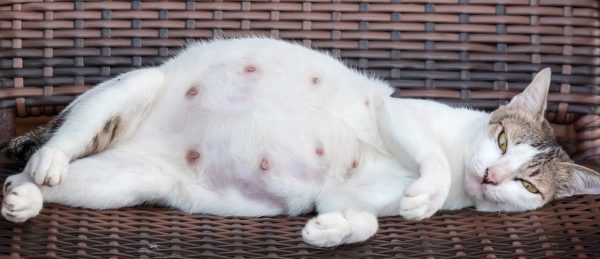
Cat Pregnancy Stages
There are five cat pregnancy stages.
- Stage 1: Fertilization. A litter of kittens can have more than one father depending on how many toms the queen has mated with. This is called “superfecundation.”
- Stage 2: Early Stage. At this stage, the cat may suffer from nausea, and her appetite may decrease. By week three, this will begin to pass. These symptoms may be mistaken for other illnesses, such as feline panleukopenia or diabetes.
- Stage 3: Middle Stage. As the cat pregnancy progresses, the cat will begin putting on weight as the kittens start to grow. Increasing the cat’s diet will aid fetal growth.
- Stage 4:Pre-Labor. A day or two before a cat gives birth, she will stop eating and her temperature will drop.
- Stage 5: Labor and Delivery. A cat will go into labor between days 63 and 65. An hour into labor, the first kitten will be born. Subsequent kittens will follow every 15 to 20 minutes.
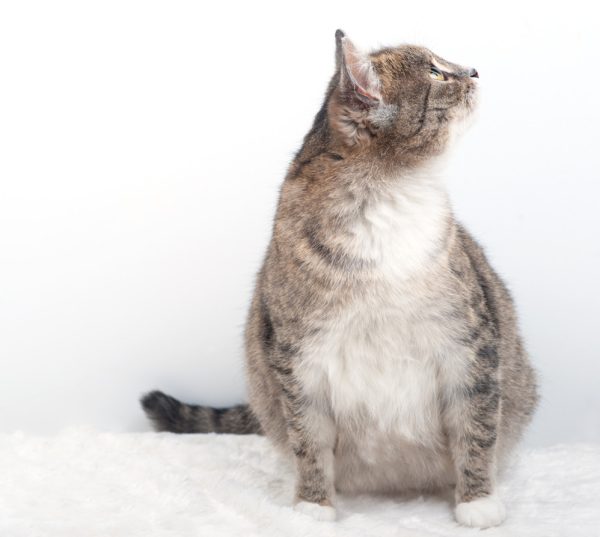
Cat Pregnancy Symptoms
It may not be possible to spot the early signs of pregnancy in a cat. The first indicator may be that the cat’s nipples become more obvious and pinker in color. This is called “pinking up.” Eventually, the cat will start putting on weight. Closer to the day of birth, her milk glands will start to fill.
During the early stages of a cat’s pregnancy, a rush of hormones and changes to the uterus could bring about morning sickness. This will be apparent if the cat loses her appetite or begins vomiting. Signs of fatigue may also be visible. This phase often lasts for the first few weeks.
Perhaps one of the more obvious signs will be a noticeable change in behavior. Hormonal changes will prompt the cat to start looking for a nesting site where she will hide her kittens. She will instinctively look for a place that is well-hidden and dry. It is not unusual for a cat to find several nesting sites so that she has choices in case of any threat to her preferred nest. At home, owners may notice this behavior in the last two weeks of the pregnancy.
To help, provide the cat with a bed or bedding in the preferred nesting spot. Make sure that the cat can snuggle into the bedding, but that the kittens will not get caught up in it. Cats will often choose cupboards, drawers, beds, sheds, and wardrobes as nesting sites.
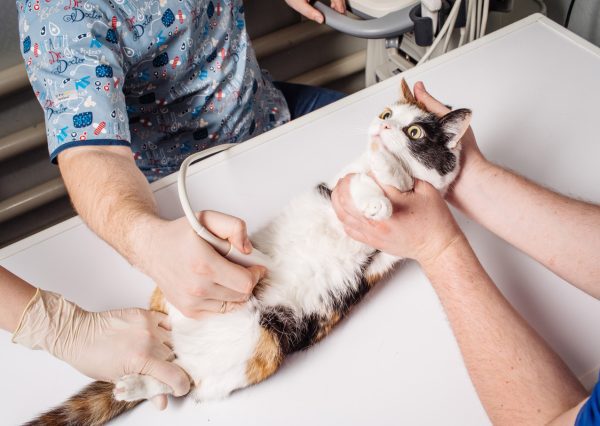
How to Tell if a Cat Is Pregnant
The best way to tell whether a cat is pregnant is to consult a vet. By visiting the vet, it may be possible to find out how many kittens a cat is carrying.
There are a few ways that a vet will assess a cat to see if she is pregnant. These include:
- Feeling the belly of the cat
- Conducting an ultrasound. This can only be done after day 16 and will not give any indication of the number of kittens a cat is carrying.
- Using an X-ray. This can determine the expected size of the litter. However, X-rays are not guaranteed to be accurate and cannot be carried out until after day 42.
It is possible to have a cat pregnancy test. However, the cost can be prohibitive. The test will look for the presence of a hormone called relaxin. This hormone relaxes the cat’s cervix, helping to ease the birthing process. Relaxin will not be present until 20 to 25 days after insemination.
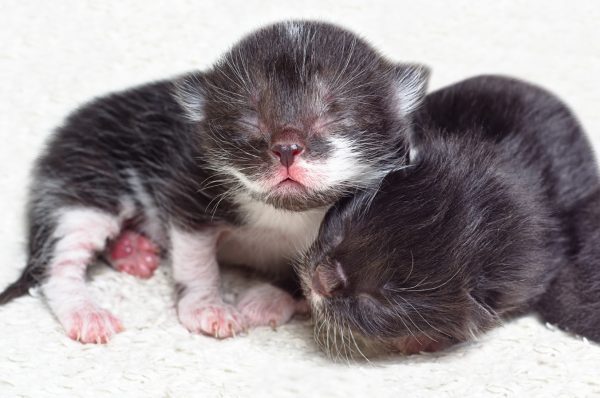
Caring for Newborn Kittens
Once the kittens are born, the mother will keep them warm by encircling them. Because kittens cannot hear when they are born, the mother cat will purr, and the vibrations will prompt the kittens to move closer to her.
Newborn kittens are also attracted to the scent and warmth of their mother’s nipples, which is where they get colostrum—a type of milk that contains antibodies to protect the kittens from disease.
During the first week after birth, the kittens will double in weight. They will then triple in weight by week three. This rapid growth is brought about by the high fat and protein content found in a mother cat’s milk, which the kittens will feed on for several hours each day.
For the first two to three weeks, the kittens will be heavily reliant on the mother to keep them warm, feed them, and for defecation. After week four, the kittens will learn how to use a litterbox by copying the mother. By week six, the kittens will be able to groom themselves.
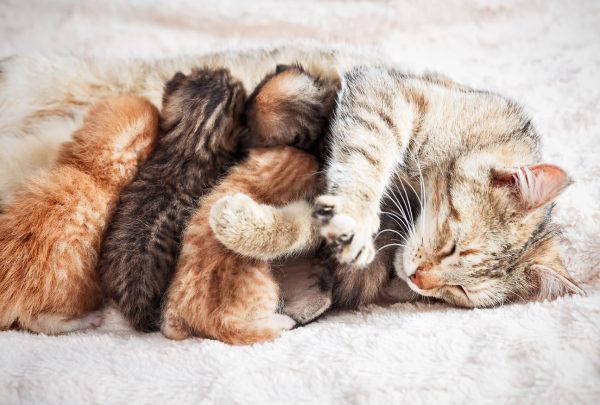
Cats and Pregnancy Risks
To ensure a healthy pregnancy and birth, it is important not to touch the cat’s belly. Examinations of a cat should only be carried out by a trained veterinarian. In some cases, dystocia or birth difficulties may occur. In this instance, seek assistance from a veterinarian. Problems to look out for include:
- 20 minutes of intensive labor without a kitten being produced
- If a kitten that is visible at the queen’s vulva has not been expelled after 10 minutes
- If a trapped fetus brings pain to the queen
- If the queen is lethargic, has a high temperature, or seems depressed
- If fresh blood is lost from the queen’s vulva for more than 10 minutes
False pregnancy in cats is rare but possible. This occurs when a queen is induced to ovulate but fails to conceive. In this situation, mammary development may occur, and the cat might act as though it has given birth.



